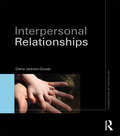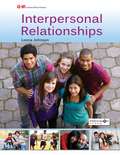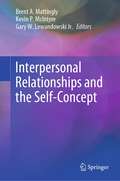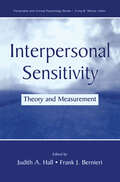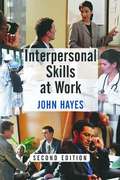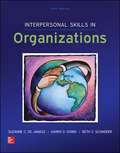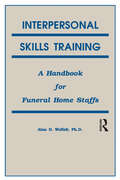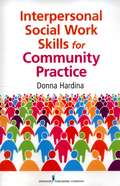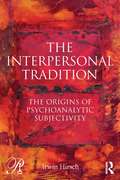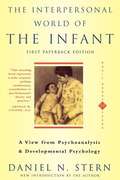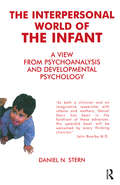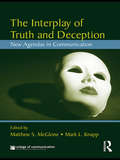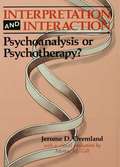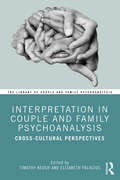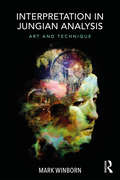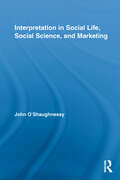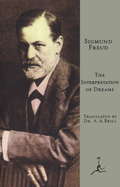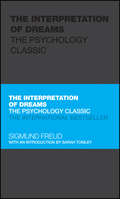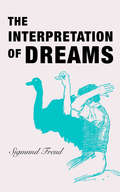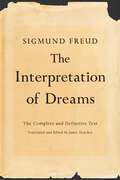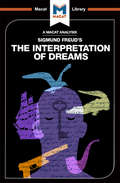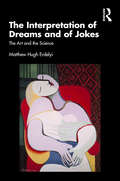- Table View
- List View
Interpersonal Relationships (Foundations of Psychology)
by Diana Jackson-DwyerWith a more specific focus than the all-encompassing textbook, each title in the Foundations of Psychology series enables students who are new to psychology to get to grips with a key area of psychological research, while also developing an understanding of basic concepts, debates, and research methodologies. In this book Diana Jackson-Dwyer presents an introductory survey of classic and recent research on relationships and the theories that underpin them. The book starts with a brief overview of the place of relationships within the history of psychology and of their evolutionary roots: our need to belong, to attach and to affiliate. After a look at methodology, it considers different types of relationships: kinship, friendship, loving and mating. Theories are advanced to explain the formation, maintenance and breakdown of relationships. The book draws on a wide array of contemporary research, and covers issues ranging from rising divorce rates to cultural variations in mating patterns, the issue of gay marriage, and the effect of the internet on relationships. Each chapter contains numerous pedagogical features which will help students to engage with the material: Chapter-specific learning objectives and summaries of key points Study boxes presenting reflective exercises, research questions, and issues for discussion Glossaries and suggestions for further reading Assuming no prior knowledge of the subject, Interpersonal Relationships provides an accessible and up-to-date overview of this vibrant area of psychology. The book will be ideal reading for students who are new to higher-level study - whether at school, college or university, and will also be useful for first-year undergraduate students taking introductory courses in psychology.
Interpersonal Relationships and the Self-Concept
by Brent A. Mattingly Kevin P. McIntyre Gary W. LewandowskiThis volume provides an overview of the theoretical and empirical work on relationship-induced self-concept change that has occurred over the last 10-15 years. The chapters in this volume discuss the foundations of relationship self-change, how and when it occurs, how it influences relationship decisions and behavior, and how it informs and modifies subsequent knowledge structures, all examined over the course of the relationship cycle (i.e., initiation, maintenance, and dissolution). Additionally, this volume identifies novel applications and extensions of the relationship self-change literature, including applications to health and behavior, intergroup relations, and the workplace. Among the topics discussed: Self-disclosure in the acquaintance processCommitment readinessBolstering attachment security through close relationshipsSelf-concept clarity and self-changeThe role of social support in promoting self-developmentRelationship dissolution and self-concept changeIntergroup and sociocultural factors of self-expansionSelf-concept change at workMeasurement of relationship-induced self-concept change Interpersonal Relationships and the Self-Concept serves both as a comprehensive overview of the existing empirical research as well as a roadmap for future research on self-change, including a discussion of emerging theoretical frameworks. It will interest researchers focusing on romantic relationships, self and identity, and the intersection of self and relationships, spanning the disciplines of psychology, sociology, communication, and family studies.
Interpersonal Sensitivity: Theory and Measurement
by Judith A. Hall Frank J. BernieriInterpersonal sensitivity refers to the accuracy and/or appropriateness of perceptions, judgments, and responses we have with respect to one another. It is relevant to nearly all aspects of social relations and has long been studied by social, personality, and clinical psychologists. Until now, however, no systematic or comprehensive treatment of this complex concept has been attempted. In this volume the major theorists and researchers of interpersonal sensitivity describe their approaches both critically and integratively. Specific tests and methods are presented and evaluated. The authors address issues ranging from the practical to the broadly theoretical and discuss future challenges. Topics include sensitivity to deception, emotion, personality, and other personal characteristics; empathy; the status of self-reports; dyadic interaction procedures; lens model approaches; correlational and categorical measurement approaches; thin-slice and variance partitioning methodologies; and others. This volume offers the single most comprehensive treatment to date of this widely acknowledged but often vaguely operationalized and communicated social competency.
Interpersonal Skills at Work: Goal Directed Behaviour At Work
by John HayesIn this age of e-business, there is an increasing over-reliance on electronic communication and insufficient attention paid to the management of face-to-face relationships. In this fascinating text, John Hayes addresses this significant workplace issue by examining the nature of interpersonal skill: the goal-directed behaviours used in face-to-face interactions in order to achieve desired outcomes. He argues that interpersonal competence is a key managerial skill which can distinguish the successful from the unsuccessful. Providing a clearly structured and comprehensive overview of the interpersonal skills essential for effective functioning at work, this book presents a micro-skills approach to development that can be used to improve interpersonal competence, as well as explaining, through the use of illustrations and practical examples, how to read the actual or potential behaviour of those around us. This knowledge can then be used to guide the way in which we relate to others as we learn to manage our relationships more effectively. This book will be ideal for practising managers and students of business and management studies and psychology. The skills it promotes make it of great value for those in a wide range of professions (including teachers, doctors, nurses, social workers and police officers) in their everyday working environment.
Interpersonal Skills In Organizations (Fifth Edition)
by Suzanne C. De Janasz Karen O. Dowd Beth Z. SchneiderInterpersonal Skills in Organizations by de Janasz, Dowd, and Schneider takes a fresh, thoughtful look at the key skills necessary for personal and managerial success in organizations today. Exploding with exercises, cases, and group activities, the book employs an experiential approach suitable for all student audiences. The book is organized into 4 distinct sections (Understanding Yourself, Understanding Others, Understanding Teams, and Leading) that can be used collectively or modularly depending on the instructors' preferences and students' needs. The emphasis in this edition focuses on making the text more current along with making the text pedagogically effective for students and instructors.
Interpersonal Skills Training: A Handbook for Funeral Service Staffs
by Alan WolfeltThis comprehensive handbook provides a solid foundation in helping skills related to successful funeral service practice.
Interpersonal Social Work Skills For Community Practice
by Donna HardinaSpecifically dedicated to the "skills" that social workers need to advance community practice, this creative book is long overdue. Grounded in the wisdom and evidence of well-honed interpersonal social work skills. . . Donna Hardina's new text takes community practice to a higher level than ever before developed in book form; indeed she displays the most thorough understanding of research on community practice that I have read in any community practice text.
The Interpersonal Tradition: The origins of psychoanalytic subjectivity (Psychoanalysis in a New Key Book Series)
by Irwin HirschIn The Interpersonal Tradition: The Origins of Psychoanalytic Subjectivity, Irwin Hirsch offers an overview of psychoanalytic history and in particular the evolution of Interpersonal thinking, which has become central to much contemporary psychoanalytic theory and practice. This book of Hirsch’s selected papers provides an overview of his work on the topic over a thirty year period (1984-2014), with a new introductory chapter and a brief updating prologue to each subsequent chapter. Hirsch offers an original perspective on clinical psychoanalytic process, comparative psychoanalysis and psychoanalytic theory, particularly explicating the many ways in which Interpersonal thinking is absolutely central to contemporary theory and practice. Each chapter is filled with theoretical explication and clinical examples that illustrate the degree to which the idiosyncratic person of each psychoanalyst inevitably plays a significant role in both analytic praxis and analytic theorizing. Key to this perspective is the recognition that each unique individual analyst is an inherently subjective co-participant in all aspects of analytic process, underscoring the importance that analysts maintain an acute sensitivity to the participation of both parties in the transference-countertransference matrix. Overall, the book argues that the Interpersonal psychoanalytic tradition, more than any other, is responsible for the post-modern and Relational turn in contemporary psychoanalysis. Based on a range of seminal papers that outline how the Interpersonal psychoanalytic tradition is integral to understanding much of contemporary psychoanalytic thought, this book will be essential reading for practitioners and students of psychoanalysis.
The Interpersonal World of the Infant: A View from Psychoanalysis and Developmental Psychology
by Daniel N. SternChallenging the traditional developmental sequence as well as the idea that issues of attachment, dependency, and trust are confined to infancy, Stern integrates clinical and experimental science to support his revolutionizing vision of the social and emotional life of the youngest children, which has had spiraling implications for theory, research, and practice.
The Interpersonal World of the Infant: A View from Psychoanalysis and Developmental Psychology
by Daniel N. SternThis book attempts to create a dialogue between the infant as revealed by the experimental approach and as clinically reconstructed, in the service of resolving the contradiction between theory and reality. It describes the several ways that organization can form in the infant's mind.
Interpersoonlijke psychotherapie bij posttraumatische stressstoornis: Een nieuwe vorm van traumabehandeling
by John C. MarkowitzDit boek biedt een nieuwe effectieve behandeling voor posttraumatische stressstoornissen (PTSS) door middel van Interpersoonlijke Psychotherapie. In Interpersoonlijke psychotherapie bij posttraumatische stressstoornis leest u dat IPT een minder bedreigende maar net zo effectieve behandelmethode als PE (Prolonged Exposure) is. Daarbij heeft IPT een hogere respons en minder drop-out, vooral bij patiënten met een comorbide depressieve stoornis. Dat blijkt uit de gedetailleerde bespreking van de gerandomiseerde klinische trial waarin drie vormen van psychotherapie met elkaar werden vergeleken.IPT is gebaseerd op de theorieën over hechting en interpersoonlijk functioneren. Deze therapievorm benadrukt dat mensen sociale dieren zijn en verbindt de gevoelens van de patiënt met hun interpersoonlijke context. IPT verbindt interpersoonlijke theorie met interventies die praktisch, pragmatisch en klinisch relevant zijn. Binnen IPT worden vier mogelijke centrale thema’s onderscheiden: rouw om een belangrijk verlies; een conflict met een belangrijke, andere persoon; een grote verandering in sociale rollen of een tekort in interpersoonlijke relaties.Het boek bespreekt gangbare behandelingen voor PTSS, wat PTSS is en hoe de diagnose wordt gesteld. Vervolgens worden de basisprincipes van IPT toegelicht om verder te gaan met de toepassing van IPT voor patiënten met PTSS. In de hoofdstukken 4 tot en met 9 volgt de praktische uitwerking van de behandeling die 14 sessies in beslag neemt verdeeld over 3 fases, geïllustreerd met veel casuïstiek. Aan het eind van het boek wordt ingegaan op moeilijke situaties en bijzondere omstandigheden en is er een hoofdstuk praktische tips voor de therapeut.Het boek richt zich voornamelijk op therapeuten op het gebied van IPT maar bevat ook interessante hoofdstukken voor onderzoekers.Dr. Markowitz is expert op het gebied van psychotherapie, cognitieve therapie en medicatie. Hij is hoogleraar klinische psychiatrie aan Columbia University in New York en onderzoeker aan het New York State Psychiatric Institute.
Interplay: The Process of Interpersonal Communication
by Ronald B. Adler Lawrence B. Rosenfeld Russell F. Proctor IIWith its unique blend of compelling topics and rich pedagogy, Interplay: The Process of Interpersonal Communication, Fifteenth Edition, offers a perfect balance of research and application to help students understand and improve their own relationships. No other book prepares students better to start improving their relationships beginning with the first day of class.
The Interplay of Truth and Deception: New Agendas in Theory and Research (New Agendas in Communication Series)
by Matthew S. McGlone Mark L. KnappDuring the past 30 years, there have been a steadily increasing number of scientific and popular publications dealing with lying and deception. Questions about the extent to which public officials are deceptive are standard fare in current magazines and newspapers. This volume aims to present on a more precise conceptualization of this phenomenon, manifested in some well-known constructions like spin, hype, doublespeak, equivocation, and contextomy (quoting out of context). The contents of the volume have been generated for the New Agendas symposium at the University of Texas College of Communication, and all the authors are young, leading-edge researchers offering innovative perspectives and explorations of lying and deception in various contexts. This volume will appeal to scholars, researchers, and advanced/graduate students in communication, media, and psychology. It is written to the level of advanced undergraduates, and it is appropriate for use in courses covering lying and deception.
Interpretation and Interaction: Psychoanalysis or Psychotherapy?
by Jerome D. OremlandIn recent decades the relationship between psychoanalysis and psychotherapy has been a focal point for debate about the distinctiveness of analysis as a particular kind of therapeutic enterprise. In Interpretation and Interaction, Jerome Oremland invokes the interventions of "interpretation" and "interaction," rooted in the values of understanding and amelioration, respectively, as a conceptual basis for reappraising these important issues. In place of the commonly accepted triadic division among psychoanalysis, exploratory psychotherapy, and supportive psychotherapy, he proposes a new triad: psychoanalysis, psychoanalytically-oriented psychotherapy, and interactive psychotherapy. Anchoring his classification in what he terms the "orientation of the therapy" rather than the "orientation of the therapist," Oremland submits that analysis and psychoanalytically-oriented psychotherapy strive systematically to interpret the therapeutic interaction as expressed in the transference. Interactive psychotherapy, on the other hand, uses the transference selectively to ameliorate psychic stress. Interpretation and Interaction is enriched by a concluding chapter from Merton Gill, a preeminent authority on the therapeutic process. Gill's critical appreciation of Oremland's proposals amounts to an illuminating refinement of his own position on the relationship between psychoanalysis and psychotherapy. Scholarly in conception, thoughtful in tone, and pragmatic in yield, Interpretation and Interaction is a clarifying addition to the psychoanalytic theory of psychotherapy. It will have the practical consequence, in Gill's words, of "aiding clinicians in retaining their analytic identities and their analytic orientation across the spectrum of their therapeutic work."
Interpretation in Couple and Family Psychoanalysis: Cross-Cultural Perspectives (The Library of Couple and Family Psychoanalysis)
by Timothy Keogh Elizabeth PalaciosThis collection of contemporary clinically-oriented papers covers a range of theoretical approaches to the fundamentally important technical issue of interpretation. It offers thought-provoking, cross-cultural clinical perspectives about interpretation with illustrations from cutting edge clinical practice with couples and families. Divided into three sections, the first part of the book examines interpretation within the broader field of psychoanalysis, and notes how it has been applied to couple and family psychoanalysis. Part II considers the current use of interpretation with couples, including how it informs assessment, while Part III focuses on its application with families and considers a broad range of key topics, including the nature of family, social and intergenerational links, the arrival of a newborn, same sex couples’ families, bereavement in a family, and families with adolescent children. Each chapter includes a lively discussion piece. Interpretation in Couple and Family Psychoanalysis: Cross-Cultural Perspectives represents a major contribution to the field of couple and family psychoanalysis. It reflects the fruits of an unparalleled era of global collaboration and the resultant re-shaping of approaches to clinical practice with couples and families. Mental health professionals dealing with couples and families will find it to have immediate relevance to their clinical work, either in their institutional or private practice.
Interpretation in Jungian Analysis: Art and Technique
by Mark WinbornAnalytic interpretation is fundamental to the process of psychoanalysis, Jungian analysis, and psychoanalytic psychotherapy. Interpretation is the medium by which the psychoanalytic art form is transmitted. What one chooses to say in analysis, why one chooses it, how one says it, when one says it; these are the building blocks of the interpretive process and the focus of Interpretation in Jungian Analysis: Art and Technique. This volume is the first of its kind in the literature of analytical psychology. Until now, the process of interpretation has been addressed only briefly in general Jungian texts. Interpretation in Jungian Analysis provides an in-depth exploration of the process, including the history of analytic technique, the role of language in analytic therapy, the poetics and metaphor of interpretation, and the relationship between interpretation and the analytic attitude. In addition, the steps involved with the creation of clear, meaningful, and transformative interpretations are plainly outlined. Throughout the book, clinical examples and reader exercises are provided to deepen the learning experience. The influence of the Jungian perspective on the interpretative process is outlined, as are the use of analytic reverie and confrontation during the analytic process. In addition to the historical, technical, and theoretic aspects of interpretation, this book also focuses on the artistic and creative elements that are often overlooked in the interpretive process. Ultimately, cultivating fluidity within the interpretive process is essential to engaging the depth and complexity of the psyche. Interpretation in Jungian Analysis will be of great interest to psychoanalysts and psychotherapists of all theoretical orientations and will be essential reading for students of analytical psychology.
Interpretation in Social Life, Social Science, and Marketing (Routledge Interpretive Marketing Research)
by John O'Shaughnessy'Interpretation' is used as an umbrella for bringing together a wide range of concepts and developments in the philosophy of social science that provide the foundation for clear thinking about social phenomena. In his new book, John O’Shaughnessy familiarises the reader with the nature of interpretation and its importance in social life, decision making in social science enquiries and consumer marketing, thus offering a multidisciplinary approach to problems of bias and uncertainty. Thus, this book is novel in its outlook and comprehensive in its approach. Whereas past studies in interpretation have focused on hermeneutical methods, O’Shaughnessy goes further considering the role of interpretation in social interactions, in undertaking scientific work, in the use of statistics, in causal analysis, in consumer evaluations of products and artifacts and in interpreting problematic situations together with the corresponding biases arising from emotional happiness and the concepts employed.
The Interpretation of Dreams: The Psychology Classic (Capstone Classics Ser.)
by Sigmund FreudFor his historical period, The Interpretation of Dreams revolutionized the study of dreams and led to greater understanding of the aspects of the human personality as it related to psychopathology. This modern edition of the Interpretation of Dreams was translated to English by Daniel T. O'Hara and Gina Masucci MacKenzie and they made some changes to the previous edition. included extensive footnotes by Freud and the translators, endnotes by the translators, and an extensive introduction that included background material on Freud and his Times. The translators also gave an extensive bibliography including other works by Freud and biographies written about him. Finally, the translators provided comments from famous personages, briefly discussed translation issues, and asked readers insightful questions.
The Interpretation of Dreams: The Psychology Classic (Capstone Classics)
by Sigmund FreudPart of the bestselling Capstone Classics Series edited by Tom Butler-Bowdon, this collectible, hard-back edition of The Interpretation of Dreams provides an accessible and insightful edition of this important work of psychology Sigmund Freud's The Interpretation of Dreams introduced his ground-breaking theory of the unconscious and explored how interpreting dreams can reveal the true nature of humanity. Regarded as Freud's most significant work, this classic text helped establish the discipline of psychology and is the foundational work in the field of psychoanalysis. Highly readable and engaging, the book both provides a semi-autobiographical look into Freud’s personal life – his holidays in the Alps, spending time with his children, interacting with friends and colleagues – and delves into descriptions and analyses of the dreams themselves. Freud begins with a review of literature on dreams written by a broad range of ancient and contemporary figures – concluding that science has learned little of the nature of dreams in the past several thousand years. Although the prevailing view was that dreams were merely responses to ‘sensory excitation,’ Freud felt that the multifaceted dimensions of dreams could not be attributed solely to physical causes. By the time Freud began writing the book he had interpreted over a thousand dreams of people with psychoses and recognised the connection between the content of dreams and a person’s mental health. Among his conclusions were that a person’s dreams: Prefer using recent impressions, yet also have access to early childhood memories Unify different people, places, events and sensations into one story Usually focus on small or unnoticed things rather than major events Are almost always ‘wish fulfilments’ which are about the self Have many layers of meaning which are often condensed into a single image The Interpretation of Dreams: The Psychology Classic is as riveting today as it was over a century ago. Anyone with interest in the workings of the unconscious mind will find this book an invaluable source of original insights and foundational scientific concepts. This edition includes an insightful Introduction by Sarah Tomley, a psychology writer and practicing psychotherapist. Tomley considers paints a picture of Freud's life and times, reveals the place of The Interpretation of Dreams in the context of Freud's other writings, and draws out the key points of the work.
The Interpretation of Dreams (Great Works That Shape Our World Series)
by Sigmund FreudPublished at the turn of the century, The Interpretation of Dreams introduces readers to Freud’s theory of the unconscious with respect to dream interpretation and is widely regarded as one of Freud’s most significant works. Here Freud considers why we dream and what it means in the larger picture of our psychological lives, delving into theories of manifest and latent dream content, the special language of dreams, dreams as wish fulfillments, the significance of childhood experiences, and much more. Encompassing dozens of case histories and detailed analyses of actual dreams, this landmark text presents Freud’s legendary work as a tool for comprehending our sleeping experiences.
The Interpretation of Dreams: The Complete And Definitive Text (Dover Thrift Editions)
by Sigmund Freud A. A. BrillUntil the beginning of the twentieth century, most people considered dreams unworthy of serious consideration. Sigmund Freud, however, had noticed that they formed an active part in the analysis of his patients, and he gradually came to believe that they represent struggles by the unconscious to resolve conflicts. In this classic of psychology, Freud explains the dual nature of dreams - their apparent content and their true, if hidden, meaning - as well as the concept of wish fulfillment and a universal language for interpreting dreams.This groundbreaking work also contains Freud's introduction of the notion that sexuality plays an important role in childhood, a theory that deeply shocked his contemporaries. Psychological journals rejected the book, and scientific publications ignored it, but the author recognized it as containing his greatest insights. The Interpretation of Dreams eventually helped set the stage for psychoanalytic theory, and it remains Freud's most original work.
The Interpretation of Dreams: The Complete and Definitive Text
by Sigmund Freud James StracheyWhat are the most common dreams and why do we have them? What does a dream about death mean? What do dreams of swimming, failing, or flying symbolize? First published by Sigmund Freud in 1899, The Interpretation of Dreams considers why we dream and what it means in the larger picture of our psychological lives. Delving into theories of manifest and latent dream content, the special language of dreams, dreams as wish fulfillments, the significance of childhood experiences, and much more, Freud, widely considered the "father of psychoanalysis,” thoroughly and thoughtfully examines dream psychology. Encompassing dozens of case histories and detailed analyses of actual dreams, this landmark text presents Freud’s legendary work as a tool for comprehending our sleeping experiences. Renowned for translating Freud’s German writings into English, James Strachey--with the assistance of Anna Freud--first published this edition in 1953. Incorporating all textual alterations made by Freud over a period of thirty years, it remains the most complete translation of the work in print. Completely redesigned and available for the first time in trade paperback
The Interpretation of Dreams
by William J JenkinsThere is arguably no more famous book about the arts of interpretation and analysis than Sigmund Freud’s 1899 Interpretation of Dreams. Though the original edition of just 600 copies took eight years to sell out, it eventually became a classic text that helped cement Freud’s reputation as one of the most significant intellectual figures of the 19th and 20th centuries. In critical thinking, just as in Freud’s psychoanalytical theories, interpretation is all about understanding the meaning of evidence, and tracing the significance of things. Analysis can then be brought in to tease out the implicit reasons and assumptions that lie underneath the interpreted evidence. Interpretation of Dreams is a masterclass in building telling analyses from ingenious interpretation of evidence. Freud worked from the assumption that all dreams were significant attempts by the unconscious to resolve conflicts. As a result, he argued, they contain in altered and disguised forms clues to our deepest unconscious urges and desires. Each must be taken on its own terms to tease out what they really mean. Though Freud’s theories have often been criticized, he remains the undisputed master of interpretation – with his critics suggesting that he was, if anything, too ingenious for his own good.
The Interpretation of Dreams and of Jokes: The Art and the Science
by Matthew Hugh ErdelyiThe Interpretation of Dreams and of Jokes provides a unique and integrative introduction to dream science. It addresses a notable gap in cognitive psychology on the subject of dreams and explores significant overlaps between the phenomena of dreams and jokes. Bringing together extensive research from cognitive psychology, neuroscience and psychoanalysis, the book provides a balanced approach to dream science that is underpinned by experimental and theoretical research. It considers the significance of dreams and their relationships to jokes, examining how both require an understanding of latent content in which context and individual differences play a large part. The book outlines a history of dream research and dream science and includes several original dream extracts for discussion. The book’s chapters explore how we can interpret meaning in dreams, how dreams might be indicators of inner psychological and somatic states, whether dreams can be used in problem-solving and the relationship between dreams and aphasia, memory and waking consciousness. This groundbreaking book will be essential reading for researchers and students from psychological and psychoanalytic backgrounds who are interested in the analysis and science of dreams.
